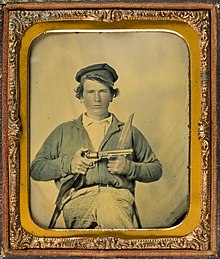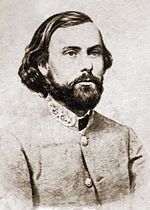
The Battle of Prairie Grove was a battle of the American Civil War fought on December 7, 1862. While tactically indecisive, the battle secured the Union control of northwestern Arkansas.
The Battle of Whitney's Lane was a small, but psychologically important, land battle of the American Civil War fought on May 19, 1862, in north-central Arkansas.

The Battle of Cotton Plant also known as Action at Hill's Plantation or Action at Cache River or Action at Round Hill was fought during the American Civil War in Woodruff County, Arkansas. Frustrated in its attempt to march to Little Rock by a lack of supplies, the Union Army of the Southwest under the command of Samuel Ryan Curtis moved south down the White River. Curtis's army encountered a Confederate force led by Albert Rust on the east bank of the Cache River near Cotton Plant. Rust was only able to bring two Texas cavalry regiments into action. These horsemen attacked the Federal advance guard under Charles Edward Hovey, but after a spirited fight, Union reinforcements arrived and drove off the Texans. Rust's force made a disorderly retreat and Curtis's army was able to march south to Clarendon before veering east to occupy Helena on the Mississippi River.

The Battle of St. Charles was fought on June 17, 1862, at St. Charles, Arkansas, during the American Civil War. Earlier in 1862, a Union Army force commanded by Major General Samuel R. Curtis moved against Little Rock, Arkansas, but became bogged down in the Batesville area due to lack of supplies. The Union leadership decided to send a naval force from Memphis, Tennessee, up the White River to resupply Curtis's men. Major General Thomas C. Hindman, the Confederate commander in Arkansas, had fortifications constructed near St. Charles to stop the Union movement. Two artillery positions were built, and three ships, including CSS Maurepas, were scuttled to obstruct the river.
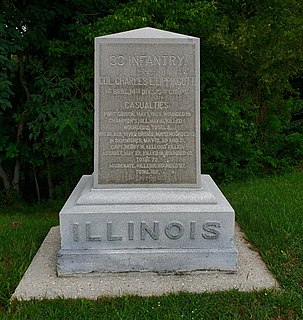
The 33rd Illinois Infantry Regiment was an infantry regiment from Illinois that served in the Union Army during the American Civil War. A number of the soldiers were college students and graduates, and for a time the regiment included a 17-piece band. The unit fought at Fredericktown in 1861, Cotton Plant in 1862, the Vicksburg campaign and Fort Esperanza in 1863, and at Spanish Fort in 1865. The original enlistees were mustered out in October 1864 while the veterans and recruits were mustered out in December 1865.
The 30th Arkansas Infantry (1862–1865) was a Confederate Army infantry regiment during the American Civil War. This regiment was also called the 5th Arkansas Cavalry, the 5th Trans-Mississippi Regiment or 39th Regiment after April, 1863. This regiment was converted to mounted infantry for Price's Missouri Expedition in 1864 and was known as Rogan's Arkansas Cavalry. There were two regiments officially designated as the 30th Arkansas Infantry. The other 30th Arkansas served east of the Mississippi River and was redesignated as the 25th Arkansas Infantry.
The Battle of Van Buren was fought at Van Buren, Arkansas, on December 28, 1862, during the American Civil War. After defeating Confederate forces led by Major General Thomas C. Hindman at the Battle of Prairie Grove on December 7, 1862, Union forces under Brigadier Generals James G. Blunt and Francis J. Herron prepared for a raid against the Confederate positions at Van Buren and Fort Smith. Disease, lack of supplies, and desertion had previously forced Hindman to begin withdrawing most of his force from the area. Setting out on December 27, the Union troops struck an outlying Confederate cavalry unit near Drippings Spring, north of Van Buren, on the morning of December 28. The Confederate cavalry fled to Van Buren, which was then overrun by Union troops.
Reid's Arkansas Battery (1862), was a Confederate artillery battery that served during the American Civil War. Another Arkansas battery, the 1st Arkansas Light Artillery, a.k.a. the Fort Smith Artillery, was also once known as "Reid's Battery". Captain Reid had commanded the Fort Smith Artillery during the Battle of Wilson's Creek, but left that organization and later organized a second battery that is the subject of this article.
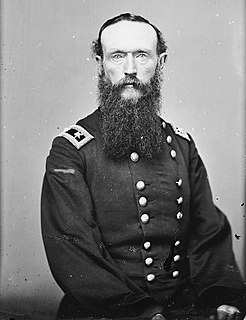
The Battle of Bayou Fourche saw Union forces under the overall command of Frederick Steele clash with Confederate forces led by Sterling Price near Little Rock, Arkansas. The only fighting occurred when Steele's cavalry commanded by John W. Davidson crossed to the south side of the Arkansas River and compelled the Confederate cavalry under John S. Marmaduke to abandon its defensive position behind Bayou Fourche. Price's outnumbered forces evacuated Little Rock and withdrew south to Arkadelphia. The Union occupation of Little Rock was the final action in a campaign that started on August 18 when Steele's troops marched west from DeValls Bluff.

The 9th Texas Cavalry Regiment was a unit of mounted volunteers that fought in the Confederate States Army during the American Civil War. The regiment fought at Round Mountain and Bird Creek (Chusto-Talasah) in 1861, Pea Ridge, Siege of Corinth, Second Corinth, Hatchie's Bridge and the Holly Springs Raid in 1862, and in the Atlanta campaign, Franklin, and Murfreesboro in 1864. The unit fought dismounted at Second Corinth and Hatchie's Bridge before being remounted as cavalry for the remainder of the war. The regiment surrendered to Federal forces on 4 May 1865 and its remaining personnel were paroled.

The 15th Texas Cavalry Regiment was a unit of cavalry volunteers mustered into the Confederate States Army in March 1862 and fought during the American Civil War. In July 1862 the unit was dismounted and served the remainder of the war as infantry. The regiment was captured at Arkansas Post in January 1863. After being exchanged three months later, the much-reduced 15th Texas was consolidated with two other regiments and assigned to Patrick Cleburne's division in the Army of Tennessee. The consolidated regiment fought at Chickamauga, Missionary Ridge, and Ringgold Gap in 1863. After a re-consolidation, the regiment fought in the Atlanta Campaign, and at Franklin and Nashville in 1864. After a final consolidation the troops fought at Averasborough and Bentonville in 1865. The regiment's 43 surviving soldiers surrendered to Federal forces on 26 April 1865.

The 32nd Texas Cavalry Regiment, sometimes incorrectly named Andrews's 15th Texas Cavalry Regiment, was a unit of volunteer cavalry mustered into the Confederate States Army in May 1862 and which fought during the American Civil War. The regiment was formed around companies from Richard Phillip Crump's 1st Texas Cavalry Battalion which fought in Indian Territory and at Pea Ridge. Many of the soldiers died of disease in the unhealthy camps near Corinth, Mississippi. The cavalrymen were dismounted in July 1862 and served as infantry for the rest of the war. The regiment fought at Richmond, Ky., Stones River, and Chickamauga in 1862–1863, in the Meridian and Atlanta campaigns and at Nashville in 1864, and at Spanish Fort and Fort Blakeley in 1865. The regiment's 58 surviving members surrendered to Federal forces on 9 May 1865.
The Battle of Cotton Plant saw a 10,000-strong Union Army commanded by Samuel Ryan Curtis encounter a 5,000-man Confederate force led by Albert Rust. A Union advance guard commanded by Charles Edward Hovey did most of the fighting, repelling an attack by two Texas cavalry regiments led by William Henry Parsons. Union reinforcements under William P. Benton arrived and pressed the Texas cavalry and Arkansas infantry into a disorderly retreat. Curtis's army subsequently occupied Helena. Earlier in the campaign, Texas cavalry inflicted 49 casualties on a Union foraging party in the Battle of Whitney's Lane near Searcy on May 19, 1862. At the Battle of L'Anguille Ferry near Marianna on August 3, 1862 the Texas cavalry overran a Union wagon convoy.

The 16th Texas Cavalry Regiment was a unit of mounted volunteers from Texas that fought in the Confederate States Army during the American Civil War. The regiment was recruited in early 1862 and mustered into Confederate service in April 1862. The unit fought as cavalry at the Battle of Cotton Plant but it was dismounted in the summer of 1862. The 16th Cavalry served as infantry in Walker's Texas Division for the remainder of the war. The regiment fought at Milliken's Bend, Mansfield, Pleasant Hill, and Jenkins' Ferry. The unit marched to Texas in early 1865 and disbanded in May 1865.

The 3rd Texas Cavalry Regiment or South Kansas-Texas Mounted Volunteers was a unit of mounted volunteers that fought in the Confederate States Army during the American Civil War. The regiment fought at Wilson's Creek and Chustenahlah in 1861, Pea Ridge, Corinth siege, Iuka, Second Corinth, and the Holly Springs Raid in 1862, Thompson's Station in 1863, and at Yazoo City, in the Atlanta campaign, and at Nashville in 1864. The regiment fought dismounted at Iuka and Second Corinth before being remounted for the rest of the war. The regiment surrendered to Federal forces in May 1865 and its remaining 207 men were paroled.

The 27th Texas Cavalry Regiment, at times also known as Whitfield's Legion or 1st Texas Legion or 4th Texas Cavalry Battalion, was a unit of mounted volunteers that fought in the Confederate States Army during the American Civil War. First organized as the 4th Texas Cavalry Battalion or Whitfield's Legion, the unit served dismounted at Pea Ridge and First Corinth. Additional companies from Texas were added and the unit was upgraded to the 27th Texas Cavalry Regiment or 1st Texas Legion later in 1862. Still dismounted, the unit fought at Iuka and Second Corinth. The regiment was remounted and fought at Holly Springs in 1862, Thompson's Station in 1863, and at Yazoo City, Atlanta, Franklin, and Third Murfreesboro in 1864. The regiment surrendered to Federal forces in May 1865 and its remaining soldiers were paroled.

The 3rd Louisiana Infantry Regiment was a unit of foot soldiers from Louisiana that fought in the Confederate States Army during the American Civil War. The regiment distinguished itself at Wilson's Creek in 1861. The 3rd Louisiana fought at Pea Ridge, First Corinth, Iuka, and Second Corinth in 1862. The unit defended Vicksburg in 1863 where it was captured. At Vicksburg, the unit's fortification was twice blown up by powerful land mines. The surviving soldiers were paroled and exchanged, after which they performed guard duty for the rest of the war.
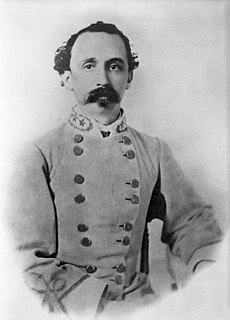
The 6th Texas Cavalry Regiment was a unit of mounted volunteers that fought in the Confederate States Army during the American Civil War. The regiment fought at Chustenahlah in 1861. The following year the unit fought at Pea Ridge, First Corinth, Second Corinth, Hatchie's Bridge, and Holly Springs. The 6th Texas Cavalry participated in the fighting at Thompson's Station in 1863, the Atlanta campaign, and the Franklin–Nashville Campaign in 1864. The regiment formally surrendered to Union forces in May 1865 and its remaining soldiers were paroled.

The 1st Missouri Field Battery was a field artillery battery that served in the Confederate States Army during the American Civil War. The battery was formed by Captain Westley F. Roberts in Arkansas in September 1862 as Roberts' Missouri Battery and was originally armed with two 12-pounder James rifles and two 6-pounder smoothbore guns. The unit fought in the Battle of Prairie Grove on December 7, as part of a Confederate offensive. Roberts' Battery withdrew after the battle and transferred to Little Rock, Arkansas, where Roberts resigned and was replaced by Lieutenant Samuel T. Ruffner.

The 9th Missouri Sharpshooter Battalion, also known as Pindall's Missouri Sharpshooter Battalion, was a unit that served in the Confederate States Army during the American Civil War. The battalion was formed in late 1862, in compliance with an earlier authorization by the Confederate States Congress for each brigade to have an associated battalion of sharpshooters. When first formed, the men had no unique qualifications to serve as sharpshooters and were drawn from a defunct artillery battery, a partisan rangers unit, and infantrymen. The unit saw action at the Battle of Prairie Grove in December 1862.

